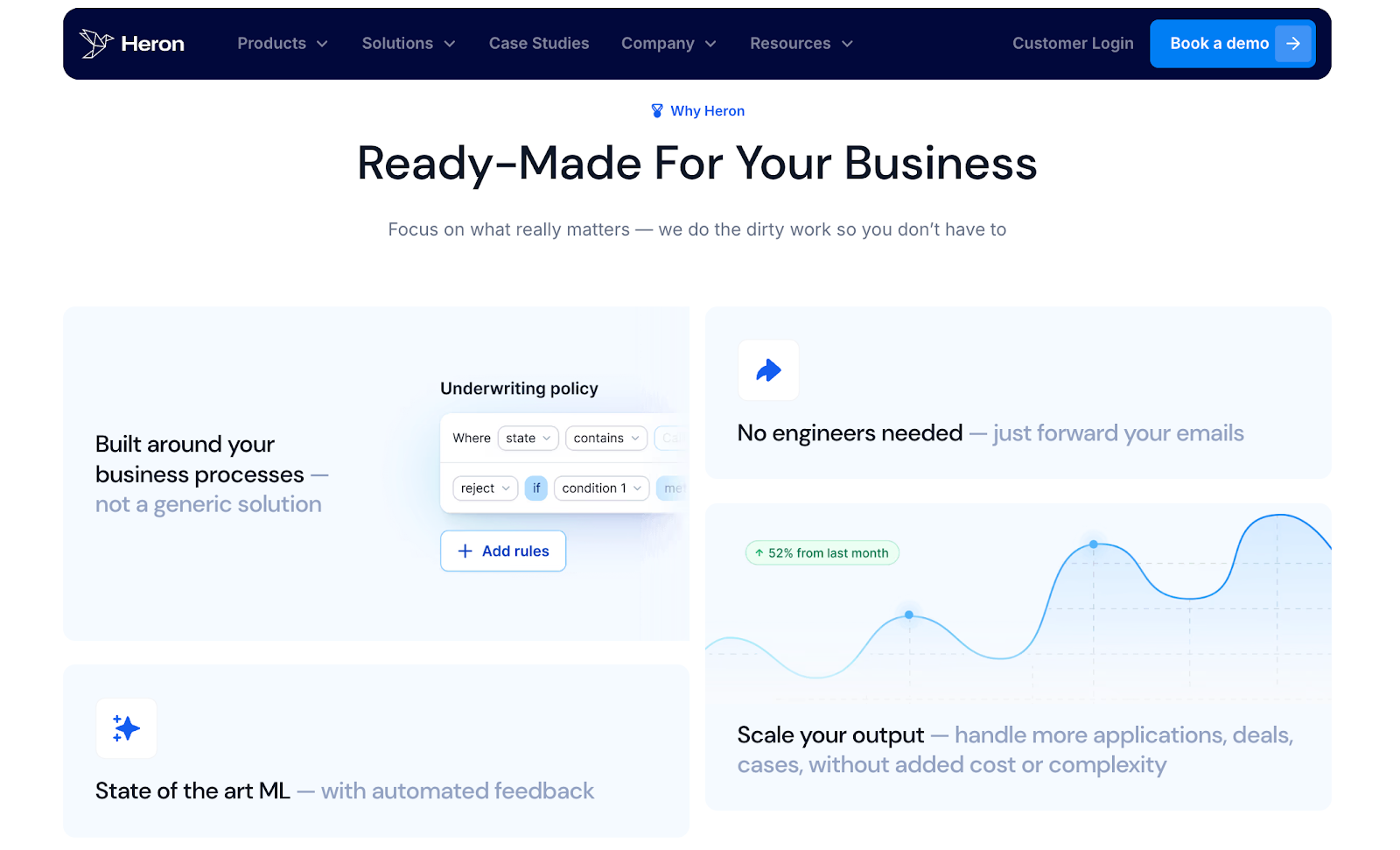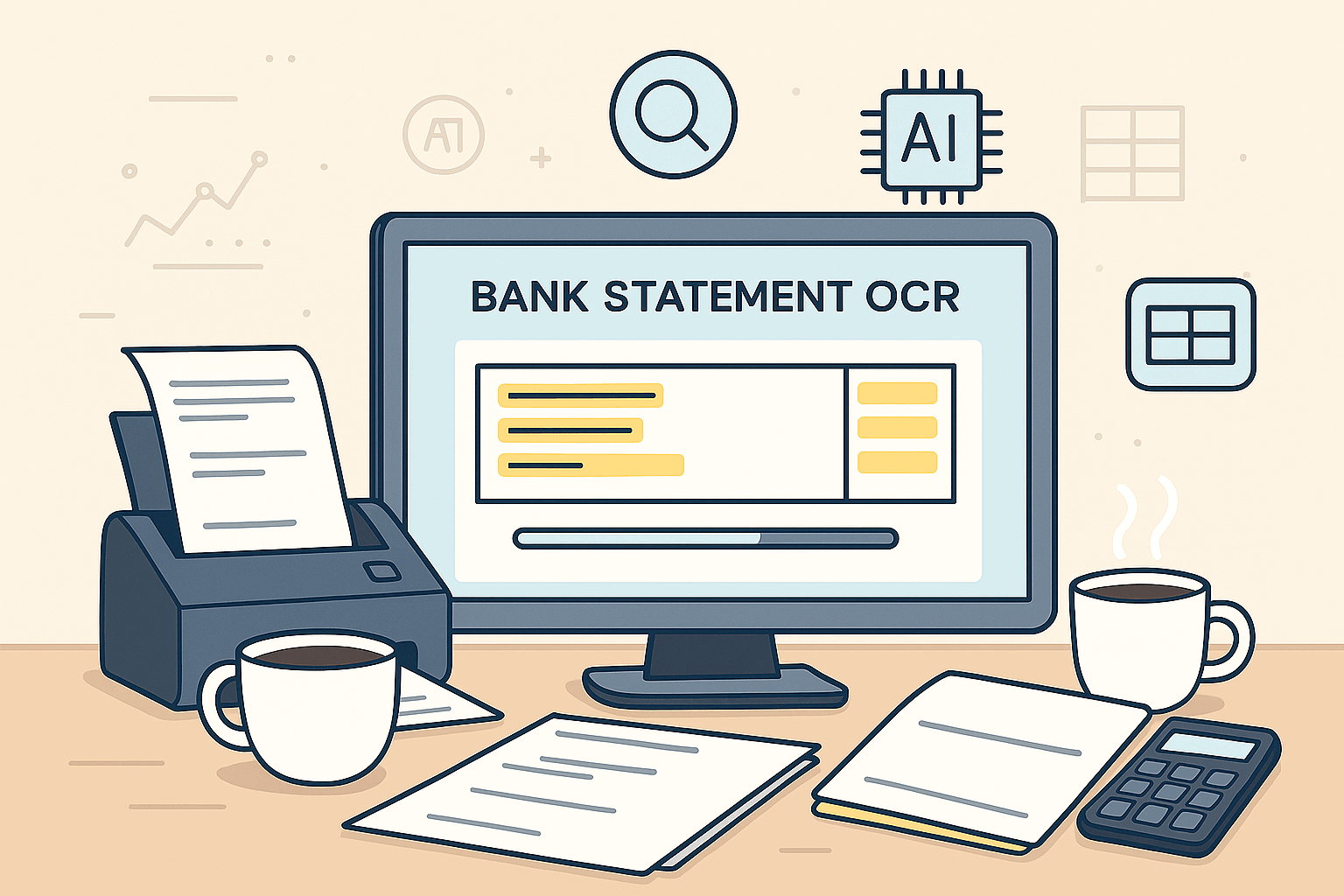Have you ever spent hours reviewing business bank statements, retyping numbers, or chasing missing details just to get clean financial data?
For funders handling multiple deals a day, this kind of manual work slows everything down. It creates bottlenecks, increases errors, and keeps your team stuck in endless paperwork.
That’s where bank statement OCR comes in.
This guide walks you through what it is, how it works, and why it’s become essential for modern funders.
What Is OCR?
Optical character recognition (OCR) is a tool that helps you extract data from scanned or digital files like handwritten text, tax forms, or other financial documents. It reads the text and numbers inside these files and turns them into editable data that your system can use.
This means you can process documents faster instead of typing everything by hand. You can upload a file, extract columns of information, and send it straight into your accounting software or other internal tools.
With document OCR, you can handle more applications, improve your financial processes, and keep your records accurate.
It also supports comprehensive data processing agreements, giving you more control over how information moves through your system.
What Is Bank Statement OCR?
Bank statement OCR helps you process bank statements faster and with fewer errors.
It reads information from PDF bank statements or credit card statements and converts it into structured data your system can use.
When you upload a statement, the software scans it, identifies key fields like account numbers, transaction amounts, and dates, and then organizes that data in a clear format.
The software automatically sends extracted data to your accounting system or underwriting tools to save time and reduce manual work.
Regular Bank Statement OCR vs AI-Powered OCR: What’s the Difference?
Regular bank statement OCR software focuses on turning printed or typed text into machine-readable data. It works well when you process clear, structured bank statement data, especially from smaller file sizes.
However, it often struggles with complex layouts or unclear scans, which can increase error rates. It only copies text from fixed spots on a page without understanding what the words mean. This means you still have to review and fix the results by hand.
AI-powered OCR works differently. It uses advanced AI technologies and deep learning models to read and understand the context. It can even handle unstructured layouts and handwritten text with much better accuracy.
It learns from patterns, improving accuracy over time and reducing manual work. These systems can also automate data extraction, helping you process more statements in less time.
What Bank Statement OCR Offers MCA Funders and Brokers
Bank statement OCR can help funders and brokers in a lot of ways. Let's talk in detail about how it can make your process stronger and more efficient:
Faster Processing and Underwriting
With OCR, you can extract data from bank statements in seconds instead of spending hours on manual data entry.
The system identifies and pulls that information instantly. This helps you review applications and approve advances faster while maintaining accuracy.
It also means your team can focus more on evaluating opportunities rather than sorting through documents.
Get Accurate Data from Bank Statements
OCR identifies each data point precisely, reducing common human mistakes during data entry.
For instance, it captures transaction amounts, payment frequencies, and merchant deposits with consistency.
Accurate data makes your financial reporting more dependable and strengthens your risk assessment. This reliability leads to smarter and faster funding decisions.
Lower Operational Costs
Manual reviews can be time-consuming and costly, especially when your team handles large volumes of applications.
OCR automation reduces these operational costs by replacing repetitive tasks with fast, automated extraction.
You don’t need to scale your staffing as your deal volume grows, keeping overhead costs stable while productivity increases.
Better Financial Insight
Once OCR converts your statements, you can export data into your accounting or underwriting software for detailed financial analysis.
You’ll see spending trends, irregular withdrawals, or sudden drops in deposits, helping you evaluate business stability more effectively. This insight supports stronger, data-backed funding decisions.
Features You Should Look for in a Bank Statement OCR Software
Now that we've talked about the benefits bank statement OCR offers your underwriting team, the next thing you should know is what features to look for.
Although the features you want ultimately depend on your unique business needs, here are some features that your chosen OCR software should always have.
Advanced OCR for Accurate Extraction
A good bank statement OCR starts with accurate data extraction. You need software that can read text from scanned or digital statements, even if the files have tricky fonts, tables, or low-quality images.
When accuracy is high —around 90% or more —your team spends less time fixing errors. The system should clearly pull out key details like dates, payees, and amounts without mixing them up.
Layout-Agnostic Recognition
Bank statements vary widely between financial institutions. Your OCR should handle all of them, even new or unseen layouts, without the need for manual template setup.
A layout-agnostic or template-free system learns to recognize content based on context rather than fixed positions on the page.
Automated Validation and Detecting Fraud
Automated validation tools check the extracted data against expected patterns, spotting anomalies or missing entries instantly.
Some advanced OCRs include detecting fraud capabilities that identify unusual transactions, sudden cash movements, or inconsistent deposit trends.
Multi-Format Support and Export Options
Bank statements come in many forms, such as scanned PDFs, screenshots, or photos taken on mobile devices.
A capable OCR should handle all of these formats, including PDF, JPEG, PNG, and TIFF files.
Once processed, it should allow you to export the extracted data into structured formats like CSV, JSON, or XML.
Custom ERP Integrations
Every funding operation has its own ecosystem of software, from accounting tools to underwriting systems.
Your bank statement OCR should support custom ERP integrations to fit neatly into your existing workflow. This allows data to move directly from the OCR into your systems for review, scoring, or compliance checks.
With proper integration, your team can skip repetitive uploads, automate financial reporting, and maintain data continuity across departments.
State-of-the-Art Encryption
You handle highly sensitive financial information every day, so security is non-negotiable. Choose an OCR that uses state-of-the-art encryption both during transmission and storage.
The system should also be compliant with major data protection standards such as SOC 2, GDPR, and CCA.
Scalability and Automation
A good OCR should grow with your business. When you’re processing applications in bulk, you need a tool that can scale without compromising accuracy or speed.
Look for solutions that support batch uploads and automated workflows. This means your team can handle thousands of statements simultaneously without additional strain or delays.
Scalable automation keeps your funding process consistent, even as your volume increases.
Start Automating Bank Statement Scrubbing with Heron
Heron is an automation platform built for funders who want to move faster without adding headcount.
It turns messy financial documents into clean, structured data ready for underwriting, analysis, and decision-making.
Heron lets you process and analyze bank statements quickly in two ways: through its dashboard or API.
Uploading Bank Statements Through the Dashboard
If you prefer a simple, hands-on approach, the Heron Dashboard lets you upload files directly.
- Use your login details to access your Heron account at dashboard.herondata.io.
- From the sidebar, go to Companies. You can either create a new customer profile or open an existing one.
- Under Transactions, choose Upload transactions > PDF.
- Add any requested details in the message box, then select and upload your customer’s bank statement PDF.
- You can monitor uploads under View transactions > PDFs to check each file’s status.
Once a PDF is processed, Heron extracts and structures the transaction data. You can open the file to review the extracted results and then either approve or reject it.
Approving the file loads the transactions into Heron automatically, marking the company’s data as ready for review.
After approval, the system generates detailed outputs such as balances, profit and loss (P&L) summaries, and scorecards.
Sending Bank Statements Through the API
If you want to automate uploads or handle large volumes of bank statements, the Heron API is the best way to do it. It lets you send PDFs, enrich transaction data, and retrieve results directly from your system.
Here’s how to get started:
- Each company or applicant you work with needs an identifier in Heron. Create one by sending a POST request to /end_users. Use your company’s unique reference or ID for the end_user_id field. If the company already exists in Heron, skip this step.
- Once your end user is created, you can send transaction data in different ways:
- Direct Plaid integration: Automatically retrieves new transactions from Plaid without manual uploads.
- Send PDF bank statements: Uploads PDFs directly to Heron for processing. (PDF parsing must be enabled on your account.)
- Send system output files: If you already use services like Plaid or Ocrolus, you can send their reports instead.
- To send a PDF manually, make a POST request with the base64-encoded PDF file. You can also add optional parameters like account_id, currency, and read_us_dates (to specify date formats).
- If you’re sending transaction data directly through the /transactions endpoint, group up to 20,000 transactions per request to keep performance high.
- When you’ve finished uploading data, send a PUT request to mark the end user as ready for processing. If you’re using Plaid or PDF uploads, this happens automatically, so you can skip this step.
- Heron will notify you when processing is complete through a webhook. You can set up your webhook in the Heron Dashboard to know when your data is ready.
- Once you receive the webhook, send a GET request to pull the enriched results. This includes labeled transactions, revenue trends, and other metrics you can use for underwriting or financial analysis.
You can also visit our SMB underwriting docs to have the full guide regarding our API processes.
If you’re using Python, Heron provides example code to help you encode and upload PDFs easily. Check out our API docs for bank integrations.
Other Important Things To Know
Here are also other things you should know about Heron's capabilities:
Reviewing and Approving Uploaded PDFs
Heron checks every uploaded PDF automatically. It verifies whether balances add up correctly and runs an anomaly score to detect potential errors.
If something looks off, the dashboard will prompt you to review and manually approve the file:
- Click into the PDF to inspect it.
- Use the green Approve button to confirm and upload transactions.
Once approved, Heron loads the transactions into the system and updates the company’s record.
For larger teams, you can also enable auto-approval. If a PDF passes Heron’s internal checks, it’s approved automatically. Files that fail those checks are flagged for manual review.
Understanding Anomalies and Duplicates
Heron reviews each file and gives it an anomaly score between 0 and 1000. This score shows how different or unusual the document is compared to others from the same financial institution.
Most differences come from changes in formatting or edited PDFs. You can check these details right in the dashboard or through the API.
You can also set auto-approval rules using anomaly scores. For example, you can choose to approve files automatically if their score is below a certain number.
Heron also spots duplicate uploads. If you upload the same PDF twice for one company, the system sends a conflict message and skips the duplicate file.
Viewing Processed Data in the Dashboard
Once your PDFs are approved, you can view and analyze the extracted data in the Heron Dashboard:
- Go to All Companies to see every customer and their processing status.
- Check Data Quality for sources, accounts, and transactions.
- Open the company report to view metrics like deposits, withdrawals, debts, revenue, P&L, and risk flags.
- Review categorized transactions under the Categories tab.
Getting Enriched and Aggregated Data
After processing, Heron enriches transactions by labeling and grouping them for deeper insights. This helps you analyze business performance, detect risk, and make faster funding decisions.
Here’s what you can pull from the system:
- Heron Scorecard includes balance details, revenue estimates, cash flow metrics, and risk flags.
- Bank statement summary is a compact report summarizing transaction activity.
- Cash-based P&L shows inflows and outflows to help you understand operating cash flow.
- Historical time series lets you view monthly or quarterly financial performance.
- Estimate future performance based on historical data with Forecasts.
Scale With Confidence Using Heron's Bank Statement OCR

Heron helps you scrub bank statements faster and more accurately. You can process about 90% of bank statement PDFs with high accuracy, reaching over 99% without human review. This lets your team spend less time checking data and more time closing deals.
The platform cuts processing time by up to 75% and allows you to handle 2x as many submissions with the same team size.
It works with scanned images and supports over 50 document file formats, making it easy to manage everything from simple statements to complex reports.
Heron also connects directly with your financial systems through seamless integration. You can seamlessly import files or send clean data into your CRM, ERP systems, or other platforms like Salesforce, Zoho, or Quickbase.
FAQs About Bank Statement OCR
How is OCR used in bank statement processing?
OCR helps read and extract data from scanned or digital bank statements automatically. It recognizes printed or handwritten text, turning it into editable data. This improves operational efficiency, reduces errors, and makes it easy to process digital data from bank statements.
What is AI data extraction?
AI data extraction uses machine learning to identify, capture, and organize information from documents. It helps turn unstructured files like PDFs or images into useful data.
This process improves speed and accuracy, making it easier to analyze and move financial data into systems like Google Sheets, Excel, or CRM.
What tools can you use to export financial data to CRM?
You can use automation tools and integrations that connect accounting platforms with CRMs. These tools help transfer transaction details, balance information, customer records, and bank data smoothly. They remove the need for manual entry, keeping your CRM updated in real time.
What is the best bank statement extraction software?
Heron is the best choice for bank statement extraction. It uses AI to read, classify, and export financial data with high accuracy. It supports multiple document types and integrates easily with other platforms, helping businesses process statements fast and without errors.


